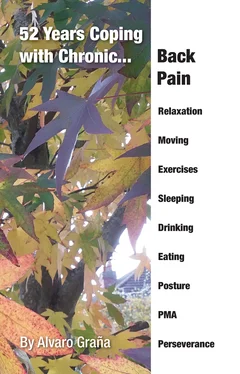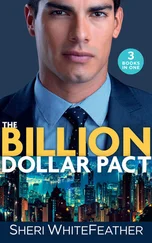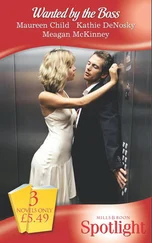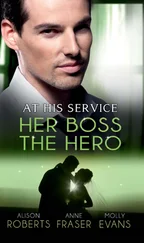• Persistent and chronic back pain
• Stress
The Way Forward – Treatments and Recommendations
Possible Solutions
1. Movement vs Inactivity
a. Movement and being active
b. The benefits of movement
c. Movement and blood circulation
d. Physical exercise
e. Other ‘structured activities’
2. Medication
a. Traditional Western Medicine
b. Complementary/Alternative Medicine
3. Mind and Body
a. Psycological Issues
b. Cognitive Behavioural Therapy
c. Mind Set – Positive Mental Attitude (PMA)
d. Acceptance of living with chronic pain
e. How to be more in control of your pain
– Controlled breathing
– Relaxation
– Meditation
– Pacing
– Resting
– Posture
– The Alexander Technique
4. General Health Recommendations
a. What your body needs
b. Stress Reduction Strategies
c. Stress may lead to Depression
d. My Continually Growing Big Plan
– Healthy Living
– Healthy Eating
– Home Treatments
Heat Treatment
Cold Treatment
– Activating Endorphins
What are endorphins?
What is the effect of endorphins?
How to boost endorphin release – Triggers
– Other creative/alternative solutions
5. Other Therapists and Health Professionals
– Chiropractic
– Osteopathy
– Acupuncture
– Other Cognotive Strategies
6. Summary of my Story
Appendices
General References
Websites
Useful Organisations
INTRODUCTION -ME AND MY BACK PAIN
I am writing this book in the hope that I will be helping people out there in the wide world, with similar problems to mine. I have been suffering with chronic back pain since my sports injury in 1961, later aggravated by arthritis in my joints in 2002.
There are many things I have learnt over the years, which I would like to share with you. Things I wish I had known earlier. But this happens in any scenario. In any case it is important to be positive and look forward.
There are many joint pain and back pain sufferers all over the world. I am one of them. It has been a long journey for me with my Chronic Back Pain caused by an injury to my lower back whilst playing basketball at the age of 16 (year 1961). This sport’s injury happened in Lima, Peru, where I was born. After my injury and for quite a while – I will call this period my first phase – I was seen by 2 orthopaedic surgeons from the Mayo Clinic, USA who were visiting Lima at the time. Their diagnosis was that I had broken two vertebrae in my lower back. Their prognosis was not good, medical science was not yet advanced enough for them to offer any treatment beyond a referral to a physiotherapist. They said that in the future surgery might be possible. They also warned me that my condition would deteriorate slowly and that in the worse case scenario I might end up in a wheelchair.
My sport’s injury happened whilst playing basketball. I was jumping to get the ball at the same time as a player from the opposing team also jumped causing a mid-air collision. I landed awkwardly on my hands and knees, and my opponent landed on my back. A number of people, including my coach, said they heard the sound of my bones cracking, which resulted in a long-lasting injury. During this phase just after the injury and right through the 1960s I was in constant pain. I was prescribed valium, anti-inflammatories and pain killers. The side effects were horrendous. I even became addicted to valium and it took me a long time and great determination to beat the addiction. I was on strong prescribed medication for forty years until I decided to try alternative solutions, which I will cover later.
In 1973 I came to England (London) to pursue post-graduate studies, I was living with chronic pain all down my spine and my right leg in spite of the strong medication. I will expand on this later.
The start of my second phase was when I decided to look into my condition in greater detail, though I still did not grasp the seriousness of my injury.
My advice would be not to leave it all to your doctor, take action, be pro-active and find out as much about your condition as possible. Speak to other health professionals, search books and the internet, and listen to other people who have experienced pain themselves and have discovered coping mechanisms.
From now on my personal experiences will be in bold and in a different font.
JOINT AND BACK PAIN
Joint and back pain account for a very high percentage of the pain experienced in the world. Joint and back pain can be under the umbrella heading of Musculoskeletal Pain. Symptoms can range from muscular spasms to inflammed joints. Nerve pain can also be experienced and it is characterised by aching – felt sometimes like an electric sensation (an electric current) running up your nerve, and a tingling sensation (a feeling of edginess). You may feel a stabbing or burning pain as well.
We are talking about pain, so let us address these questions:
– Can we accurately measure the various levels of pain people experience?
– Do we know how the brain works and responds to pain?
– Why is pain tolerated at different intensities by each individual?
– Does gender or age make any difference to how we feel and react to pain?
– What is a pain threshold?
– Can endorphins produced by our bodies be as efficient as a painkiller?
Let’s start with what pain is.
How can we define PAIN?
The International Association for Study of Pain (IASP) define pain as:
‘An unpleasant sensory and emotional experience which is due to actual or potential tissue damage or which is expressed in terms of such damage’.
Pain works as the natural warning system. It is a message sent from any part of the body to the brain (the mind) through our nervous system, to tell us that something is wrong.
Pain can be broken down into the following categories.
Types of pain
Acute Pain:The term ‘acute’ indicates a relatively abrupt onset with evident symptoms and limited duration. This can be caused by a physical event such as a fall, a sprain or break, as well as an inflammation or infection. Acute pain normally resolves itself as healing occurs.
Chronic Pain:This is long-term pain, unlike acute pain, which is normally temporary and disappears with time and treatment. Chronic pain persists after healing has occurred. Chronic pain is constant and nagging. There are many conditions which produce chronic pain including arthritis, gout, joint pain, and back ache, among others. This type of pain may be either constant or sporadic. It may be difficult to identify its cause.
Referred Pain:Referred pain is felt some distance away from its origin. Osteoarthritis of the hip, for instance, causes pain in the knee.
It is extremely important to seek professional medical advice if your pain persists or has no obvious cause.
Emotional pain:Pain is usually thought as physical, though emotional pain or mental distress can manifest itself in the body. This type of pain can be caused by being rejected, from bereavement, from problems with relationships, etc. One acute form of emotional or psychological distress is depression, a term that covers anything from feeling down and sad to extreme mental and emotional agony. Emotional or mental pain can manifest physically as a headache/migraine, stomach upset, ulcers or even muscle pain (through tension and stress) for example. The causes of these pains can include nightmares, fears, phobias, obsessions, and addictions to food, drink, drugs, etc.
Читать дальше












